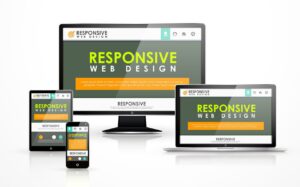Geometric shapes are fundamental visual elements defined by precise mathematical rules, including circles, squares, triangles, and more complex polygons. These shapes are the building blocks of design, offering clarity, structure, and a universal language of form.
In web design, geometric shapes play a pivotal role in creating visually engaging and user-friendly interfaces. They help organize content, guide user behavior, and establish brand identity. Their versatility makes them essential tools for both aesthetic appeal and functional design.
This blog post explores the significance of geometric shapes in web design. We will discuss their role in establishing visual hierarchy, examine various types of shapes and their applications, delve into the psychological impact of shapes, and conclude with actionable insights for designers.
The Role of Geometric Shapes in Visual Hierarchy
Explanation of Visual Hierarchy in Web Design
What is web design structure? Visual hierarchy refers to the arrangement of design elements to prioritize certain information over others. This ensures users can navigate a website effortlessly, finding key details without confusion.
How Geometric Shapes Guide User Attention
What shapes are considered design elements? Geometric shapes help direct attention by creating focal points, defining boundaries, and structuring layouts. For example:
- Circles often highlight buttons or call-to-action (CTA) elements due to their attention-grabbing nature.
- Rectangles frame sections, creating distinct zones for content.
- Triangles subtly guide the eye by pointing toward key areas.
Examples of Effective Use of Shapes to Create Hierarchy
- Landing Pages: Large rectangles define main content areas, while smaller circles highlight CTAs.
- Navigation Bars: Horizontal rectangles or lines guide users through menu options intuitively.
- Hero Sections: Overlapping shapes like circles and triangles draw attention to headlines or key messages.
Get in Touch with Our Team

Types of Geometric Shapes and Their Applications
Basic Shapes: Circles, Squares, Triangles
- Circles: Convey unity, harmony, and focus. Commonly used for icons, buttons, and avatars. Examples include logos, interface elements, and illustrations. What are the basic shapes used for designing?
- Squares: Represent stability and order. Ideal for grids, content blocks, and forms. They are one of the 5 shapes used in architecture and are often seen in web design structures.
- Triangles: Symbolize movement and direction. Often employed in navigation cues, background patterns, and modern architecture.
Complex Shapes and Patterns
- Polygons: Add creativity and uniqueness, often found in modern web design trends. These include the 10 most popular geometric patterns used in interior design.
- Abstract Shapes: Blend basic forms into patterns for a dynamic visual appeal, widely used in branding and graphic design. How do graphic designers use shape and geometry?
- Custom Icons: Combine shapes to create branding elements tailored to a site’s identity.
What Are Shapes in Design Called?
What are visual shapes in design? Shapes in design are often referred to as “design elements.” These visual shapes help organize layouts and enhance visual hierarchy in graphic design.
Psychological Impact of Geometric Shapes
How Shapes Influence User Perception and Emotions
- Circles: Associated with friendliness, inclusivity, and protection. They evoke comfort and trust.
- Squares and Rectangles: Convey reliability and professionalism, ideal for corporate or educational websites. What is the psychology of shapes in architecture?
- Triangles: Suggest action, energy, and innovation, making them popular in tech and creative industries.
The Significance of Shape Choice in Branding
What do geometric shapes symbolize in graphic design? Shapes contribute to a brand’s identity by aligning with its core message. For instance:
- Apple’s rounded logo reflects simplicity and innovation.
- Microsoft’s square grid emphasizes stability and structure.
Research Findings on User Interaction with Shapes
Studies indicate that users are drawn to symmetrical, balanced designs where shapes guide navigation. For example, rounded corners on buttons increase click-through rates as they feel more approachable than sharp edges. Why are shapes important in graphic design?
What Is Symbolism in Web Design?
Symbolism involves using shapes to represent ideas, emotions, or messages. For example, geometric patterns represent modernity and innovation, especially in graphic design.
Get in Touch with Our Team

Examples and Types of Geometric Shapes
Common Examples
- Basic Shapes: Circles, squares, and triangles are foundational forms. These are also some of the 5 most commonly used geometric shapes in design.
- Complex Shapes: Include polygons and tessellations. These are frequently found in modern architecture and interior design. What are the names of common geometric shapes in design?
Types of Geometry
- Euclidean Geometry: The simplest geometric form, focused on points, lines, and planes.
- 3D Geometry: Extends basic 2D shapes into three dimensions, used in graphic modeling and architecture. Are geometric shapes 2D or 3D?
Applications in Modern Design
Shapes are essential in both 2D and 3D forms for graphic design, computer modeling, and web layout development. They are crucial in creating effective web design patterns and structures. How are geometric patterns used in modern design?
Applications of Geometry in Design
Why Use Geometric Shapes in Design?
Geometric shapes organize content, establish visual balance, and communicate messages effectively. They are widely used in branding and layout design to guide user interaction.
How Are Shapes Used in Computer Geometric Modeling?
What shapes are used in computer geometric modeling? Shapes form the basis of 3D modeling in computer graphics. They are used to simulate architectural designs and animations.
The Significance of Geometry in Graphic Design
What is the trend in geometrical graphic design? Geometry helps graphic designers use symmetry and balance to create aesthetically pleasing and functional designs. It also enhances user interaction by aligning visual elements effectively.
Conclusion
Geometric shapes are indispensable in web design, offering tools to craft layouts, enhance usability, and create memorable branding. Their role in establishing visual hierarchy and influencing user behavior underscores their value.
Designers are encouraged to experiment with various shapes to discover innovative ways of enhancing functionality and aesthetics. Combining shapes thoughtfully can lead to unique designs that captivate audiences.
As web design continues to evolve, the use of geometric shapes will expand with advancements in technology. From 3D shapes to animated patterns, the possibilities are endless. By understanding and leveraging the power of shapes, designers can stay ahead of trends and deliver exceptional user experiences.
FAQs
What are the 5 shapes used in architecture?
Circles, squares, triangles, polygons, and rectangles are fundamental shapes in architecture.
What are the two major categories of shapes in design?
Geometric and organic shapes.
What do geometric shapes suggest in design?
They suggest order, stability, or modernity.
Where is geometric design mostly used?
In branding, architecture, and web design.
What are 10 examples of geometric shapes?
Circle, square, triangle, rectangle, hexagon, pentagon, octagon, ellipse, star, and rhombus.
What are the 8 types of geometry?
Euclidean, non-Euclidean, projective, differential, algebraic, discrete, computational, and fractal geometry.








